Since 1993 Copyright Notice
Can we travel in time?
The answer is yes!
You probably have seen a science fiction movie where a time machines was used, like" back to the future", or some others. In such movies, time machines are always created by a crazy professor. Some of those movies are funny, but using silly and wrong laws of physics. Yet some movies have an interesting approach it. Have have you ever wondered, if it would be possible to build a real, working time machine? This is not a joke, but a time machine can be build to travel into the future, but not into the past. This was done first time in PROVEN way, using Hewlett Packard atomic clocks, to prove it. Here are some examples for time travelling.
Things out there were always larger as we thought.
 I am just en electronics engineer (I studied energy and power distribution), and with these philosophical, physical matters like: "Where do we come from, and where do we go to", I am just an amateur. There are just a few common things I would like to point out, from my scientific view.
I am just en electronics engineer (I studied energy and power distribution), and with these philosophical, physical matters like: "Where do we come from, and where do we go to", I am just an amateur. There are just a few common things I would like to point out, from my scientific view.
Scientific Models. A model is, something we hope it will be useful, even though the model may be partially wrong. We put observations into pictures, and into rules and even formulas. One use of the model is, to give a quick answer to a question. So generate output to some input. Another interesting use, is to make a prediction about a new situation. Like Einstein predicted with his formulas, that a light beam follows no straight path if it passes the sun sharply. Much later, during a solar eclipse, his model was confirmed to be working indeed.
Models of the Universe. In every religion and culture there are models about the sun, moon and the stars. Though they all claim to be right, and all other religions are wrong, they do have one thing in common though: None of them gives information about size, and the age of the universe. Though the Bible mentions the order of creation in a way, scientists today say, is correct. Just not on the right time scale. (In one week). Also it is mentioned that before creation, there was no space, and no time. I would like to pick this out a little bit, because modern scientific models conform this. So it is believed recently, the heavens were created by the big bang, and before that there was nothing, also not time.
Do we live in the age. where we are right about science? Well, you need to digest this question a little bit. You can go back in time, and you will see, they also thought they were right, and older views were wrong. And those older views, also said they were right, and even much more older views, they were wrong. That goes on and on, no matter how deep you go into history. So are we right because we live in the present? That doesn't sound like a good reason to me! Our models may seem so right, but older models seemed so right, just as well. 2500 years ago, it was common sense, the earth was flat. The land stops where the sea begins, and at the end of the sea, the water falls down the edge. It rains down into hell, to evaporate there in the hell fire. This creates clouds which rise above the horizon, and give rain. This pancake model seemed proven, because sailors who went to investigate this, never returned. Their ship must have fallen off the edge, caught by the stream. Also after a some rain, clouds appear at the horizion, which is steam rising up in the skies, because steam is hot. As it cools down, like steam does, it creates waster drops, and it rains. It all makes a lot of sense, and this model was used for thousands of years, to better understand the things we see.
In the middle ages, the German scientist Keppler hat the idea, all planets circle around the earth. At least they realized, space around us was larger as thought before, by the flat earth model. Keppler wrote in his Astronomia nova, the earth is not the center of the the universe, but everything circles around the sun. Today, we know, planets do circle around the sun, but on the universe scale, almost nothing circles around the sun. Our solar system is just a micro-tiny little part of the milky way, and everything in it, circles with a spiral movement, around a black hole in the center.
All these models had one thing in common: Every time when we learned something new, things were much, much larger as we thought. I am just bringing this up, because I think assuming we have the right view on this today is probably a mistake. It can not be, just because we live here and now, we are right, with what we say. That is not a good reason. Possibly, after 1000 years, the view as we have today, will be overhauled, and then what? By the logic so far, the universe appeared always larger as science thought. So perhaps the universe as we can see it, might be only an extremely small part of something else, which is much larger, and we have no way to see it. (Google for "wormhole time travel")
Can we travel into the time?
 Time travelling into the past is not possible, but we can travel into the future. We must keep apart absolute time traveling and relative time traveling. In the absolute sense, related o our own space time (grid) we travel 24 hours per day forwarding time. Relative time traveling means you move not forward in time with the same speed as someone else in he same grid. Just take two people, and if there is a difference, the one sees himself travel faster in time, and he sees the others travel slower. Though the others will say, they travel not slower at all, and use a watch to prove it.
Time travelling into the past is not possible, but we can travel into the future. We must keep apart absolute time traveling and relative time traveling. In the absolute sense, related o our own space time (grid) we travel 24 hours per day forwarding time. Relative time traveling means you move not forward in time with the same speed as someone else in he same grid. Just take two people, and if there is a difference, the one sees himself travel faster in time, and he sees the others travel slower. Though the others will say, they travel not slower at all, and use a watch to prove it.
So is there a way, to change your own speed of time traveling? The answer is yes, by relativity theory, your own clock ticks slower, when you move faster. So if you just move faster than the others, you will travel slower into the future. It was exactly this, which was scientifically proven in October 1971, using two atomic clocks from the Hewlett-Packard company. Basically doing what Einstein predicted. Once clock was staying on the ground, the other was travelling in a fast airplane around the world.
First let's do this virtual experiment....Suppose there would be such a thing as a time machine. Just think what it physically would looks like. What would be the requirements for it's physical appearance? If we travel into time, do our clothes come with us? Suppose an assistant needs to operate the time machine for you, how will the machine keep let him stay in his own time? So how can the time machine keep items apart? This questioning points out, a time machine obviously will not transfer "objects" in time, but rather a space with the objects inside. That is however a very important assumption: Not objects, but a SPACE is transferred into TIME. The space just takes the objects with it.
Some totally wrong examples.
This here is definitely wrong, but it shows how it would feel to travel in time. When you fly by airplane in the opposite direction of the earth rotation, and it's a 9 hours flight. You would arrive 9 hours later by your own watch, but if you ask the people in your new destination, it's 15 hours later. This time shift did not happen all at once. It happened slowly. If you look outside the airplane window, you will see indeed what time travellers would see. You will see the sun (indeed!) rise much faster than normal. The observations are the same as what a time traveller would see, when looking outside, through a window of the time machine.
This following is not impossible of course, but suppose you are in a Boeing 747, and could open the window, and shout to the destination that you are on your way. A 747 flies very fast, with .90% of the speed of sound. The speed of sound is a fixed number, but the airplane, and also your mouth which produce the words, travel with 90% of the speed of sound. This means, with a message of 10 seconds, the first word you pronounced, has travelled through the air only 10% faster than the whole airplane itself, meaning the last word you pronounce is only 1 second away from you. (not 10 seconds). So the speech of 10 seconds get compressed into 1 second, and it sounds like coming from a record which plays at 10x the normal speed. And if you turn your head, and shout 'good bye' to the place where you were coming from, they would hear your words sounding like Gooooooood ....byeeeeee...... with 10x lower speed than normal.
An airplane trip can also can end deadly, when you have to fly through the a tornado, and the plane crashes. The same tornado, some hours later will reach the airport where you boarded the airplane. So from the view of the people you left behind, you will die from a future event. In the last book of Steve Hawking, I read something funny. He wanted to invite time travellers to a party. To make sure they are really capable of doing so, he send the invitation when the next day, after the party was already over. Much to his disappointment, nobody came to the party.
All of the above are strange, wrong examples of course.
How far can we go in theory?
Suppose you would be shown a a time machine. Would you expect to press a button for the year 3500, and after some light effects, and curious vibrations, you would be there? Or perhaps, the process takes longer than that? Whatever the process, "something" happens, which takes "some" time, and when that is over, you are somewhere else in time. Perhaps the transfer begins slowly, then accelerates, then slows down again, until it stops and you are at your time destination. If you choose for the last option, it means you expect, that travelling in time takes also time, giving good meaning to the word. So in that case, travelling very further, takes longer. Meaning, a time machine can not 'beam' objects, like in the StarTrek series, but will move a certain space (a coordinates system), into the future, and most of all, that takes TIME. This however means, as each individual has a limited life time, the distance a person can travel in time is limited by his own lifetime.
Reality
In October 1971, an experiment was made, and people travelled into the future indeed. It wasn't very much, but they did it, and it was scientifically proven and documented. More about this later.
More Imagination
Here is an experiment you can do yourself. It's really silly, but it will it make the right questions coming up. Build a wooden box, with a door. Go inside, and close the door. Exit the box 24 hours later, and ask somebody what date and time is. You will notice, you travelled 24 hours into the future. Let's analyse, why this is a silly example, and what's wrong with it. A fact is, you went inside, and you came out one day later. Only the thing is, INSIDE the box, time was ticking inside with the same speed as outside, and that is why you wasted your time in there. Note the word: WASTED. So your time was invested, but there was nothing in return, because clocks inside and outside had the same speed. But just suppose we could overcome this little problem, and we would be able to make the clock inside tick slower. Let's say one hour slower during the cause of one day. Now, if we achieved 1 hour difference, we travelled into time one hour, during that day. In other words, we would travel one hour per day.
Move the coordinate system
In the year 1897, as Joseph J. Thomson was investigating Stoney's prediction of the existence of the Electron, he stumbled over a strange effect. These invisible little objects increased their weight at great speed. Later he was awarded a Nobel prize for this. The French genius Poincaré picked this up, and was the first to prove E=Mc². The Dutch Professor Lorentz, was the first to capture time dilation (slow down of time) into mathematical formula, using Maxwell's equations as a starting point. These so called Lorentz transformations, are relating the speed of time, and size and mass of objects, to the speed of movement of their coordinate system. So a fast movement changes the speed of time, not just for the object itself, but rather for the coordinate system it is in.
So how far can we go?
Physical objects can not be accelerated to the speed of light, but it is indeed possible to accelerate an object such, that a detectable increase of mass begins to occur, such as Thomson proved in 1897. Not just detectable, but even precisely measurable with today's instruments. The strange thing with this is, it is only relative. So think again of the wooden box of the silly example. Just suppose it does transfer us into the future for one hour at the end of the day. How would we experience this? We can step out, and compare our watch with the watches of the people outside. We would only see our watch is one hour behind. So our own time has slowed down. But if we would have stepped out after 12 hours, the time difference would have been only 30 minutes, and if we would have stepped out after 10 seconds, we would not even notice. So time travel will not take place with a "jump", like in movies, but by a different speed of time, and you just need to wait long enough until you get there. But... how long can we wait at all? The longest is a human life time. So in order to travel 1000 years into the future, and we are willing to stay one year inside the time machine for that, we would need to slow down our own time by a factor 1000, that is a fact. So this would require a speed close to the speed of light, for which we have less than one year time to accelerate to it. However, such acceleration is not possible, with a body of flesh and blood, because our body actually can not withstand much acceleration at all. The maximum we can do is just a few G for just seconds, in a laying position. Even 1.5G creates a problem with the blood circulation if it takes too long. So time travelling, realistically speaking is possible, but at a maximum acceleration of 1.5G, we can never increase our speed far enough during one human life, to get a relevant result.
This brings us to the next question:
 Can the speed of local time be slowed down?
Can the speed of local time be slowed down?
Yes this is possible! Not just in theory. Everybody who flew by airplane, has lived in a closed world as big as the airplane cabin itself, where time ticks a tiny fraction slower, due to the high speed. Not enough to see it on a normal clock, but it can be made easily visible with an atomic clock, when you carry one in your luggage. This was first done in Oct 1971, and it proved the histori formulas by the Dutch scientist Lorentz were true. The so called Lorentz transformations are the mother of all relativity theory. These formulas describe how an object gets smaller size at higher speed, down to infinitely small at the speed of light. So it becomes difficult to understand what happens at the speed of light, when an infinitely small object is infinitely heavy and time stands still, but when we are close to the speed of light, it can all be nicely calculated.
Even in GPS systems, the slow down of time of fast moving objects play a role. Those navigation satellites in the sky, circle with very high speed around the earth, while transmitting precise impulses. Depending on their speed, relative to YOU, the GPS system calculates how much their time has actually slowed down, so how large is the error of their internal clocks. If this correction would not be made, we would not get very good accuracy.
Back in time
We need to go a little bit back into history, to understand this better, how all of this developed. At was the year 1874, when Professor George Johnstone Stoney predicted the existence of electrons. I have deepest respect for somebody, at a time when nature of electricity was fully unknown, who can come up with such a prediction. This man was so incredible ahead of his time, it was too early for everybody. Unfortunately, there was no use for electron tubes in 1874. From 1874 until 1897, used his "electrons" because they were so helpful to explain other things.
In the year 1897, Joseph J. Thomson presented a practical proof of George Stoney's prediction, using a cathode ray tube.(Yes a real cathode ray tube, so before Fleming invented the diode in 1904). Later he put this in theories, and he was rewarded the Nobel prize for the discovery of the electron. I can't help, finding George Stoney's prediction of 1874 a greater achievement.
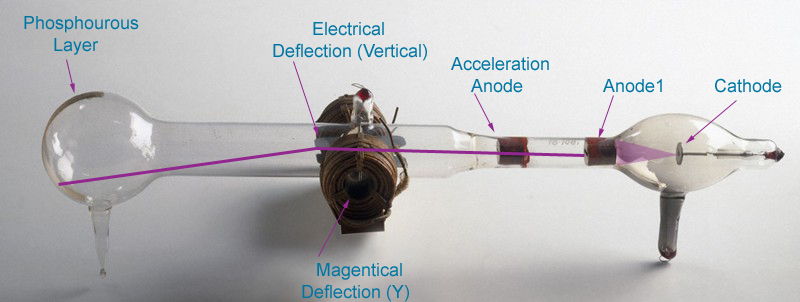
With this ELECTRON TUBE, in 1897 (this picture is Thomson's original), relativity was first time observed. Later, this (relativity!) was mathematically proved by Poincaré. After that, the TRIODE was invented by Lee de Forest, and relativity put into formulas by Lorentz, so that Einstein could use them. Actually in his first work, Einstein "forgot" to credit Lorentz for this.
Thomson experimented with electrical deflection and magnetitic deflection, at the same time. His famous experiment worked like this: He compensated the electrical deflection with the magnetitic deflection. Just because. So he would deflect the beam electrically, and then force it back to the center by a magnetic field. Not a big deal, and anyone can repeat that with some old oscilloscope tube.
Here comes however the thing he could not explain. If he increased the high voltage of the tube, of course the beam spot lights up brighter. But also, it is not in the center anymore. This effect gets much stronger if the high voltage is increased. Now, field theory of electric field and magnetic field is too complex to explain here quickly. Yet it could be concluded, from this that the electrons gain mass at higher speed. Which was totally new for those days, and all repeats, always showed the same result: An accelerated electron gains weight.
Even so, he could simply measure how much percent he needed to change the magnetic field in order to center the beam an a higher anode voltage. As magnetic field is proportional to the electric current,he could make do precise measurements. With those measurements he just played around until he found something like a formula, by which is seemed to behave. This of course was fully new to say in those days. A relation between velocity and mass! The relation between velocity and energy was known, and so now we have also are la ti on between mass and energy.
So Thomson just measured this, from an amazingly simple test set up, and he came with an experimental formula:E=3/4Mc². He had no proof whatsoever, but his results seemed to behave that way. The mathematical proof was later brought by the Frenchman Poincaré, a brilliant scientist, and he proved the correct formula is:
E=Mc²
The Dutch scientist Lorentz had s a deep understanding of the Maxwell Equations, from which the speed of light could be calculated. Lorentz had a problem though. What would happen if a person would travel with 60% of the speed of light, towards to another person who travels into his direction, also with 60% of the speed of light. Would they see each other approach with 120% of the speed of light? This can not be. So what is the observation going to be then? The answer was: Time slows down. This phenomena he described in his so called Lorentz transformations. These, together with E=Mc² supply the basic elements of the relativity theory.
Back to now
We have to stop the theory part here, but we can see it like this: Suppose you send an astronaut into space and the rocket accelerates to an unbelievable high speed. Relativity theory says, time can slow down relative to another place, but it will not slow down by itself. So inside the rocket the time doesn't seem to slow down at all. Just when the astronaut looks outside, he will see the planets outside move much faster. However, if he would make a video call with "earth" and he would hold a clock in front of the camera, we would see his clock run much too slow. His voice would sound deeper and slower, but we could hear what he says, even though -strangely- his words come from the future.
Good Science Fiction
The phenomena described before, was correctly used a book from 1898, called "the time machine", and a movie was made by this book in 1960. Many things in this story (of the year 1898), resemble theory in a fascinating way. I would like to mention the movie makers did not just have a lucky hit, but they were well advised by scientists. It is only a movie of course, and sure you see some silly things too, yet many things are done right.
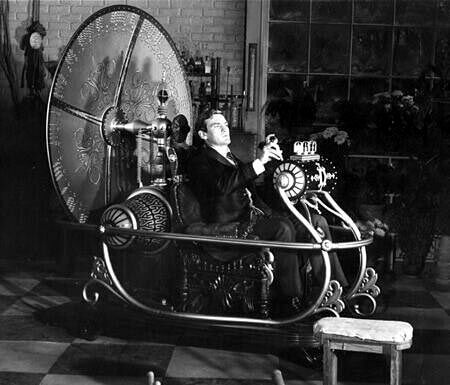
In this movie, when time travel begins, the traveller sees the sun go up and down faster and faster as his machine begins to accelerate. After he has seen the sun go up and down 100 times, it cost him only a minute to look at that, but he has travelled 100 days into the future already.
In the movie, he was alone in the house, but if somebody would have enter the room, they would have have seen him, but he would move very slow. He would look at you, but it would take him a few minutes to move his head in your direction. Presumed you don't move. Because if you move, for the time traveller, you jump around him like a movie which plays too fast, and he can't follow what you are doing.
When he stops the machine, he goes outside, and sees his house is abandoned and not taken care of for years. People in the street tell him, the owner of the house has disappeared 25 years ago without leaving a message.
Amongst the things that are wrong, is that the time machine stands still. For time travelling a very high speed is necessary. Also travelling back in time is not possible, as he did, returning to his own time. Just alone because things which are done can not be made undone. Also by the Lorenz transformations, time can only be slowed down. Yet to travel into the past, you would need to make your own time go faster, and this is impossible. The next part is about a REAL time machine.
They did it. Someone lost a microsecond.

In October, 1971, a commercial airplane took off to fly around the world three times with high speed, to prove that time is relative. On board were the crew, two scientists, and four cesium atomic beam clocks clocks, of the type Hewlett Packard 5061A, supplied by a large unit of batteries. On the ground was an identical set up, supplied by identical batteries. The formulas of Lorentz describe precisely how time slows down, when an object moves circular at high speed,through a gravity field. So the time inside those airplanes will tick slower as time on the ground, and supposing, Lorentz's formulas, are correct, this would be demonstrated in full detail. And yes, it happened as expected. After the airplane with the clocks landed again, all four atomic clocks were 220 nanoseconds behind, relative to the same clocks that stayed on earth. This was a great achievement, proving the theories of Lorentz.
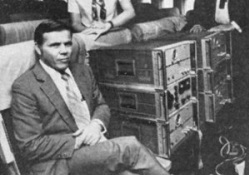 This airplane has turned into a real, working time machine, and it has traveled 220 nanoseconds into the future indeed. Today, there is little attention to this event, because we use it every day in every space application where exact time is important, but it was the first time, it was proven that two clocks will run at different speed, if they have different velocity.
This airplane has turned into a real, working time machine, and it has traveled 220 nanoseconds into the future indeed. Today, there is little attention to this event, because we use it every day in every space application where exact time is important, but it was the first time, it was proven that two clocks will run at different speed, if they have different velocity.
VOYAGER 1
In the 1970's, Voyager1 was send into deep space by the NASA, it travels with the amazing speed of 61.000 km/h, ever so since 1970. It was the most scientifically productive mission ever. We still have radio contact with it, but it's atomic batteries, and the atomic heater system are getting now so empty, all systems had to be shut down, apart from a few very low power instruments, still sending small pieces of data to earth. So knowing the temperature, it is estimated it gets too cold in there, for any of the instrument to work, around the year 2025. After that, Voyager can at least receive it's final instruction to send a radio "ping" at known moments, but no more than that. Somewhere around 2030, 60 years later, we will loose contact for ever. The systems will however last a tiny bit longer as expected, because Voyager 1 travels not only into space, but due to it's high speed over 60 years, it travels also in time. Perhaps somebody wants to calculate the length if this time travel by this, but it could be a few seconds into the future.
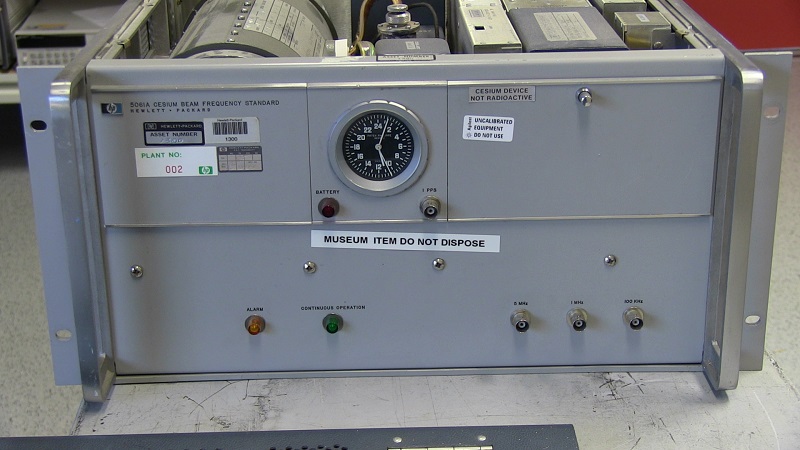
This atomic clock is one of the originals. Now stored at the Keysight company Museum, in Melbourne. In 1971, this device travelled to us from the past. So it is 200 nano Seconds younger.
Another Time machine
Mankind cannot travel to the next nearest exo planet outside the solar system because travelling over there would take 5years with the speed of light. Travelling with 0,005% of the speed of light, like Voyager one, it would still take 100.000 years. It's possible though to bring frozen micro organisms that way,but not humanity. Here the theoretical option would be to accelerate the space ship somewhere closer to the speed of light. Ignoring the absurd amount of energy needed. Like this, time slows down, and when the astronaut arrives after 100.000 earth years, his own time inside the space ship has slowed down. He would be older, but just a few years. At this moment we do not have the engines to accelerate a space craft that much, but this can not work for another reason, the human body can not withstand high acceleration for a long time.
This is what I call two very wise men.
Johannes Kepler
'As soon as someone can demonstrate the art of flying, there will be no shortage of human invaders on the moon, and Jupiter' By: Johannes Kepler, in the year 1610 in a letter to Galileo Galilei
It was clear to Kepler, going to the moon one day would be possible. Just to put yourself in this position: Try to write down what will be possible in the year 2400 and write it down in such a way, that other the people in the year 2400 praise your clear vision.
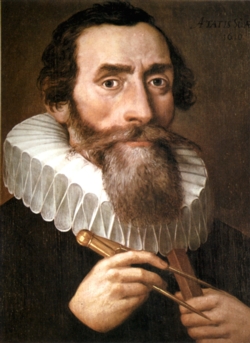 Here is just a little side information about Kepler. He was the first human being to understand the earth is not the center of the solar system. First of all, this was difficult to imagine, because ever since men look at the sky, the impression was another. Moreover, it was possible to explain and calculate almost every movement of the planets from the "flat earth" perspective, saying earth is the center of the universe. So he was considered an intelligent fool for by some.
Here is just a little side information about Kepler. He was the first human being to understand the earth is not the center of the solar system. First of all, this was difficult to imagine, because ever since men look at the sky, the impression was another. Moreover, it was possible to explain and calculate almost every movement of the planets from the "flat earth" perspective, saying earth is the center of the universe. So he was considered an intelligent fool for by some.
Something else made it more difficult to say this: Catholic church had the power over life and death, and the church said the center of the universe is the earth, and would kill people who disagree in the open This lead to enormous pressure on Kepler and his family.
The procedure for the Catholic church was barbaric and effective. First "chance" he got, was to call his works a lie. Any refusal would come to a point where he would be arrested. After arrest they have the right to torture him, in order to force him to speak the truth. Then, under torture he would at some point admit his lies, upon which they have the right to kill him. A difficulty for the church leaders was, he had political influence in high places, and they could get no arrest warrant. So they accused his mother of bewitching a neighbor, but Kepler just went over there, and got her out of prison by his influence. Good luck for her, she could withstand the torture so far, because as soon as she admitted, they would have burned her. The church tried again, and the second time they did their homework better. They tortured her for 14 months, during which time Kepler could not get her out of the church dungeons, but at least she did not admit witchcraft. Together with legal experts in very high places, Kepler finally found a procedure error, and based on that they were forced to release his mother once more. The documents about this still exist. His mother however took too much damage and she died one year after she was released from the church dungeons. This was a high price, the Kepler family had to pay to the catholic church, for saying the earth rotates around the sun.
Saint Augustine of Hippo
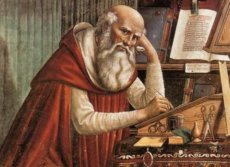 More than 1600 years ago, Bishop Augustine of Hippo wrote his 13 books, in some of which he was seeking for the scientific background of the book Genesis, the first page of the Holy Bible, describing the creation. So when it says there, first there were plants, and after that, there were animals, this makes sense, and no scientist will disagree with that. Augustine tried to bring his observations of the sky up above, in accordance with the creation. In those days there were two main cosmological theories. One said, the earth circles around the sun, because of the shade and movement of a moon eclipse is the only thing which can explain this. The other was, everything circles around the earth, which was the Christian vision. This vision was self made, because it was the only thing which could explain hell is below us, and heaven above. Augustine based his cosmological model on the Bible, but only on the original texts. In Genesis is written: 'In the beginning there was nothing, and then heaven and earth were created, and it was the first day'. This sentence holds a lot of information. It says, the cosmos was not eternally there. Also it says from the moment of it's creation, time began ticking, as this was the first day. From this, he set up a cosmological theories, which like all theories can not be proven, only compared to reality. A theory must not only be able to explain the existing situation, but must also be able make predictions. (This is elementary for a valid theory). His theory was extracted from the book of Genesis, saying the cosmos was created all at once, in less than a day, and before that there was no such thing as time. Augustine asked himself long before Einstein: What is the relation between time and matter? Well, he said, only time can makes things change. Meaning, if the time span is zero, there can be no change to matter. Putting this into relation with the cosmos, he said, before the beginning there was no such thing as time, and without time, nothing can change. The means the situation before that, was one without time, and for that reason without change. This may seem so simple, but he was touching with his fingertips one element of relativity, trying to define what is means for all items, including cosmos, when there is no such thing as time. This was one of the greatest break though ever, and 1500 years later taken over by others, as their own. We have to say, it remains a theory, so before the big bang, there was no such thing as time, but so far this theory is in use until today.
More than 1600 years ago, Bishop Augustine of Hippo wrote his 13 books, in some of which he was seeking for the scientific background of the book Genesis, the first page of the Holy Bible, describing the creation. So when it says there, first there were plants, and after that, there were animals, this makes sense, and no scientist will disagree with that. Augustine tried to bring his observations of the sky up above, in accordance with the creation. In those days there were two main cosmological theories. One said, the earth circles around the sun, because of the shade and movement of a moon eclipse is the only thing which can explain this. The other was, everything circles around the earth, which was the Christian vision. This vision was self made, because it was the only thing which could explain hell is below us, and heaven above. Augustine based his cosmological model on the Bible, but only on the original texts. In Genesis is written: 'In the beginning there was nothing, and then heaven and earth were created, and it was the first day'. This sentence holds a lot of information. It says, the cosmos was not eternally there. Also it says from the moment of it's creation, time began ticking, as this was the first day. From this, he set up a cosmological theories, which like all theories can not be proven, only compared to reality. A theory must not only be able to explain the existing situation, but must also be able make predictions. (This is elementary for a valid theory). His theory was extracted from the book of Genesis, saying the cosmos was created all at once, in less than a day, and before that there was no such thing as time. Augustine asked himself long before Einstein: What is the relation between time and matter? Well, he said, only time can makes things change. Meaning, if the time span is zero, there can be no change to matter. Putting this into relation with the cosmos, he said, before the beginning there was no such thing as time, and without time, nothing can change. The means the situation before that, was one without time, and for that reason without change. This may seem so simple, but he was touching with his fingertips one element of relativity, trying to define what is means for all items, including cosmos, when there is no such thing as time. This was one of the greatest break though ever, and 1500 years later taken over by others, as their own. We have to say, it remains a theory, so before the big bang, there was no such thing as time, but so far this theory is in use until today.
Let me briefly put up the big bang theory. So out of 'something' (beyond our imagination), with a big bang, the cosmos appeared, and time began ticking. This happened so fast it was almost instantaneously, and before that, there was no such thing as time, and you can not ask the question, what was before that. Augustine said this already 1600 years ago. When there is no such thing is as 'time' before the beginning, and the question what was before that, he said, is invalid.